VERGER: balancing, beasts, & bugs
Hey! Been a while. As it is with part-time projects, I've had to juggle working on VERGER with lots of other life stuff. Luckily, I'm back on track to bring a significantly updated and polished demo to MAGFest next month (I'll be exhibiting at MIVS; pls come say hi)!
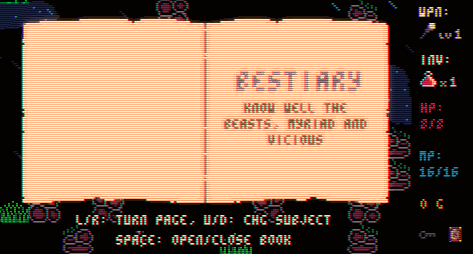
When I last wrote, I was neck deep in a rewrite of my underlying world generation and item management code. This has, for the most part, yielded the intended result of making it much easier to add items, entities, and "props" (i.e. destructible environmental objects) to the game world. The system is far from optimized, but the bones should be easier to polish than the spaghetti I was wading through before. Genericizing object data also exposed a metric ton of bugs lurking beneath ostensibly functional code, which has been humbling but invaluable.
With the scariest stuff out of the way, I've finally been able to dedicate time to long-overdue features like a more interesting landform generator, which now spits out semi-interesting islands with little peninsulas and switchbacks and whatnot:
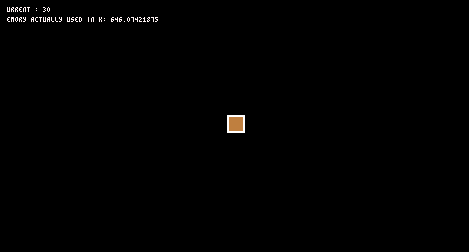
I've also been experimenting with more diverse enemy behavior like teleportation...
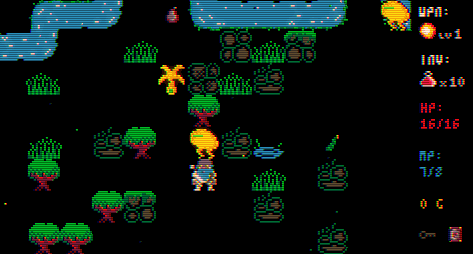
venomous ooze trails...
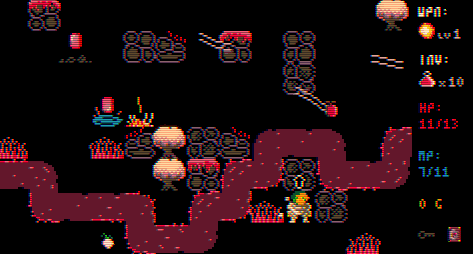
and enemies that lay eggs that hatch into new enemies:
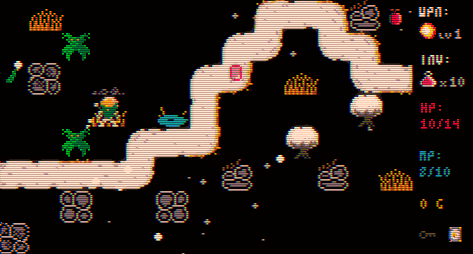
Some of these have been on my to-do list for a while; others were tests of the new object system that ended up feeling tactically and aesthetically pleasing in their own right. I've even been dipping my toes in Dijkstra maps and need/desire-based pathfinding (rather than pure A*, which all the early builds used) to inspire more organic movement and combat.
Most importantly, watching so many new elements overlap and interact has drawn my attention back to the essential work of balancing, both in the sense of strategic coherence and figuring out the best ways to deliver information to the player as gameplay becomes more complex.
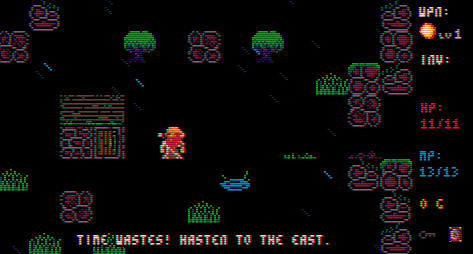
In the latter case, I've got a solid basic tutorial to teach movement, attacking, environmental destruction, item use, etc. — but this doesn't yet cover ranged items like bombs or teleportation charges. I don't want to front-load all of this instruction and overwhelm players before they've encountered their first enemy or terrain obstacle. On the other hand, I hate the idea of constantly interrupting the game to teach you small variations on familiar tasks. VERGER's control scheme is simple enough that more advanced actions are somewhat intuitive, but it's still a tricky negotiation.
Strategic/tactical balance is, in my opinion, both more difficult and more interesting. My fundamental goal for VERGER is a streamlined but earnest roguelike experience — something you can pick up and play for twenty minutes without feeling totally out of your depth that preserves, or at least evokes, the spirit of far bigger, exponentially more complex worlds. I am a fumbling, amateur interpreter of the elaborate systems that drive hardcore roguelikes, but I am thrilled by the challenge of capturing and rearranging my favorite morsels.
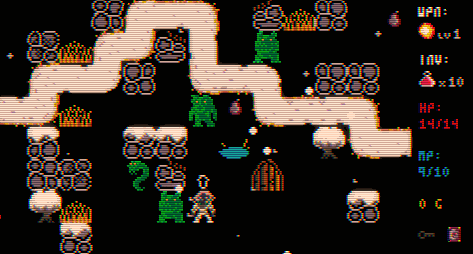
To this end, combat and exploration are shaped by a few simple but relatively dynamic vectors: physical strength (represented by "attack" and "defense" skills, as well as minor modifiers like "recoil", i.e. being knocked off the current tile); weakness or resistance to effects (elemental, persistent, stun, etc.); and terrain traversal (ability to cross rivers, wade into lakes, etc). Players must manage their own movement and reservoir of MP; enemies act based on aggression, fear, and range meters, with some special cases for variety.
Roguelikes often log actions/reactions as pure stats — percentage points, dice rolls, XP, whatever. I appreciate the information dump of this approach, but I wanted to experiment with a more minimal, intuitive interlocking of systems. In VERGER, the UI displays essential player statuses, and the in-game codex provides basic data about monsters and items, but most other interactions are represented through audio/visual cues.
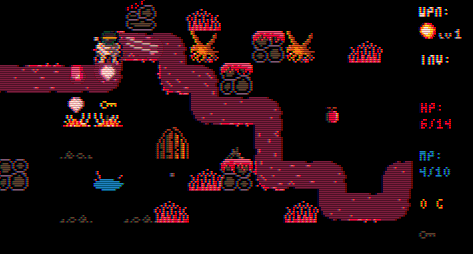
This is necessarily more oblique, but I've worked hard to structure the underlying interactions so that combat and navigation are logical (if not entirely predictable). For instance, combat results in VERGER are static — an unmodified attack of strength 1 always does 1 damage. Elemental effects (poison, ice, fire) are common across all weapons of the same "level", and resistance/weakness to a particular effect simply bumps the level of all attacks with that effect up or down. Likewise, most enemies who rely on a specific elemental attack have a resistance to that element. Of course, I'm trying out lots of little tweaks to keep players on their toes, but in general systems can be reliably decoded by carefully observing the game itself. If all this sounds weirdly simple: great, that's what I'm going for! Also: trust me, it's not.
Regarding terrain/traversal, as you can see in the GIFs, environments are currently limited to land (grass or negative space) and rivers. However, I'm in the process of adding swamps and larger bodies of water which will host unique enemies and require appropriate skills or items to enter/exit. In the slightly longer term, accessing these areas will reveal...wait for it...dungeons! But that's a whole other can of wormholes.
OK my fingernail is infected and typing sucks so gonna sign off for today. But! Thanks so much for taking the time to follow my progress, and please don't hesitate to reach out with questions, comments, lavish sums of money, etc. And! If you're going to be at Super MAGFest, I'd love for you to play the game. Til soon!
b
VERGER
a tiny roguelike in four seasons
| Status | In development |
| Author | -hexcavator- |
| Genre | Action, Adventure, Role Playing |
| Tags | 2D, Atmospheric, LÖVE, Pixel Art, Retro, Roguelike, Roguelite, Short |
| Languages | English |
More posts
- VERGER: demo nighFeb 09, 2020
- VERGER: ruminations on generationOct 05, 2019
- VERGER: throwing shadersSep 22, 2019
- VERGER: a tiny roguelike in four seasons - year oneSep 16, 2019

Leave a comment
Log in with itch.io to leave a comment.